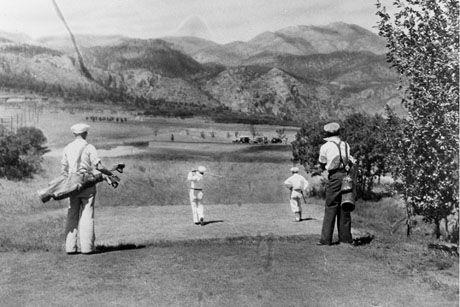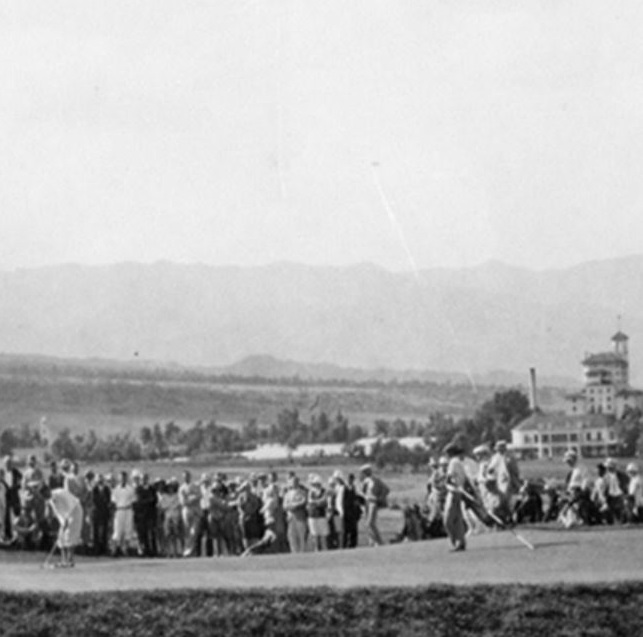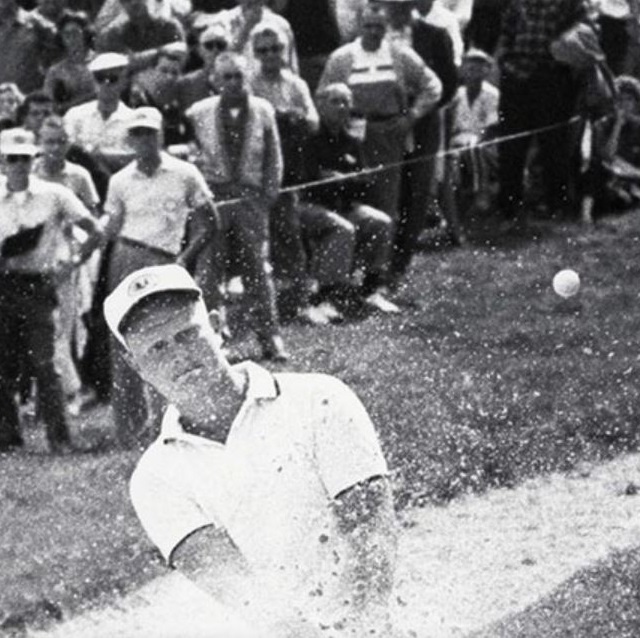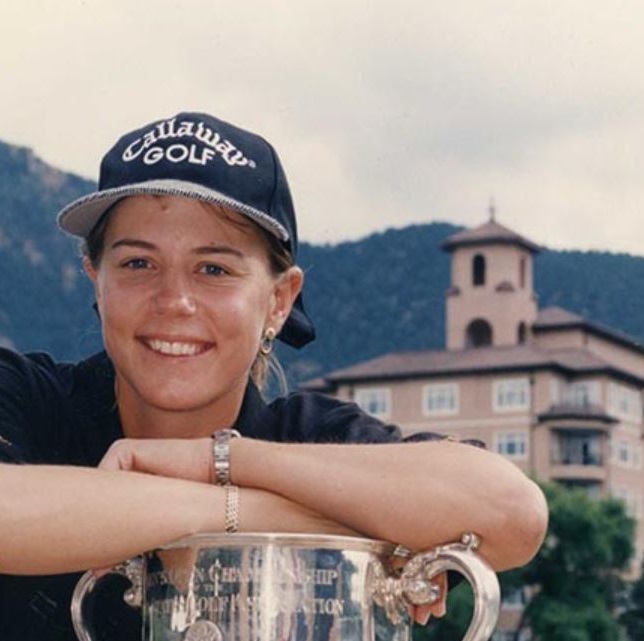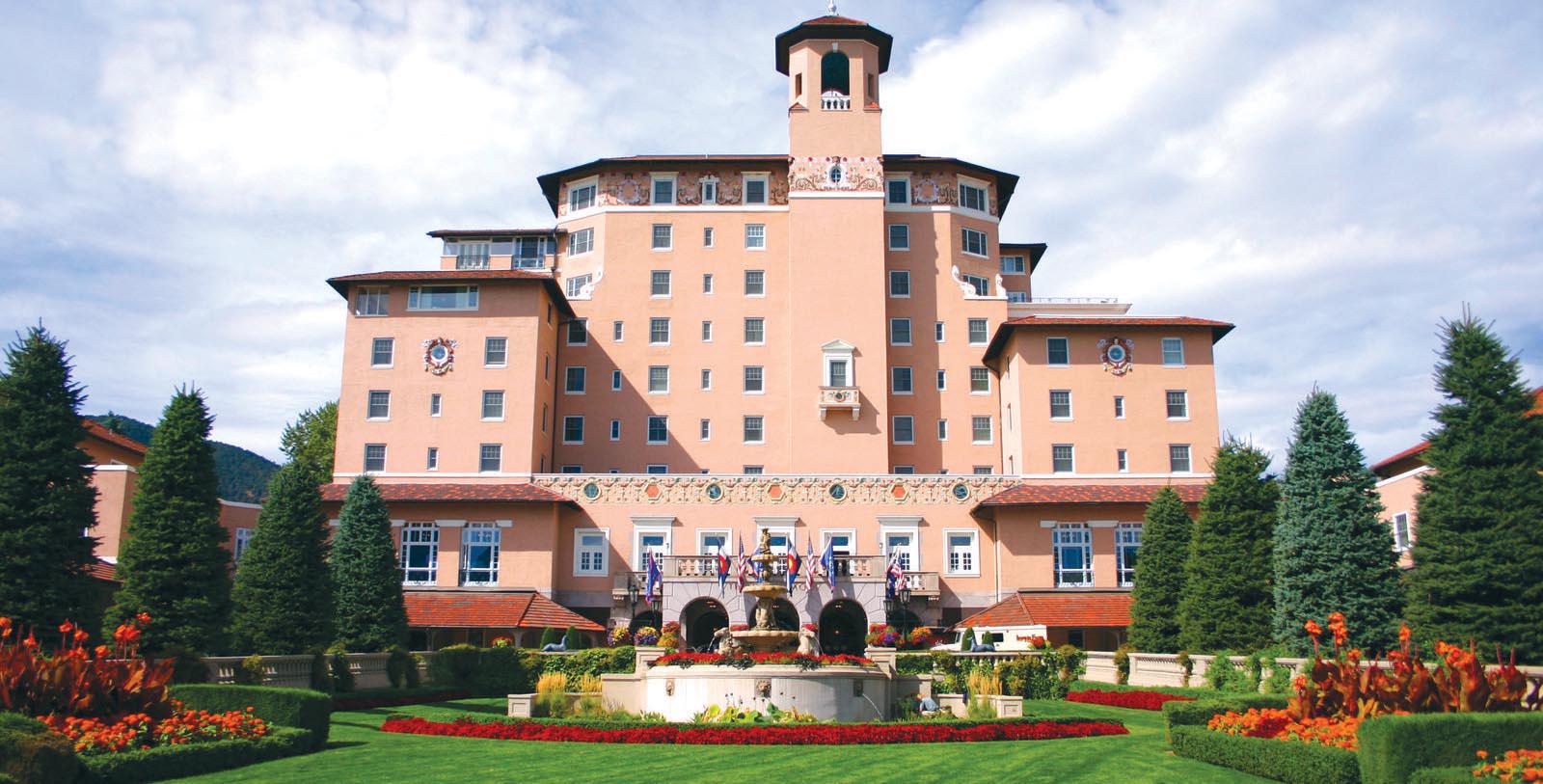Receive for Free - Discover & Explore eNewsletter monthly with advance notice of special offers, packages, and insider savings from 10% - 30% off Best Available Rates at selected hotels.
golf
Discover The Broadmoor’s two historic golf courses: The East and West Courses.
Reminisce with The Broadmoor's Golf Legends
Former Director of Golf at The Broadmoor, Dow Finsterwald, Retired Professional Golfer Annika Sörenstam, and Director of Golf at The Broadmoor, Russ Miller, come together to reflect on the history of golf at The Broadmoor.
WATCH NOWKnown as the “Grand Dame of the Rockies,” The Broadmoor offers two magnificent golf courses nestled in the Rocky Mountains: The East Course and the West Course. Guests at The Broadmoor can enjoy both while surrounded by the red rocks and white peaks of Colorado Springs’ Pike’s Peak region. With its challenging terrain and amazing mountainous vistas, the East Course has been consistently ranked among the best golf courses in the country. Its origins are quite historic, too, harkening back to the very founding of The Broadmoor itself. The first iteration of the East Course debuted as an 18-hole complex that renowned golf course architect Donald Ross had developed at the behest of the resort’s original proprietor, Spencer Penrose. (Ross was a Scottish-born immigrant who trained as a young man at St. Andrews in the 1890s. He then spent most of his career and life in the United States, where he designed many of the world’s championship courses during the “Golden Age of Golf.”) Penrose specifically commissioned Ross to create a course that would help transform his new alpine retreat into a world-class resort. Taking the request to heart, Ross proceeded to craft a terrific series of fairways that were soon to be among his finest designs.
When Broadmoor East Course finally opened alongside the rest of the resort in 1918, it was the highest golf course in the United States at an elevation of 6,400 feet. The course’s fantastic alpine layout quickly gained a celebrated reputation throughout Colorado, which attracted countless guests to The Broadmoor. To service the golf enthusiasts that were now descending upon The Broadmoor, the resort began hiring its own professionals to serve the course. The first golf professional at The Broadmoor was “Long Jim” Barnes. He was the best paid pro in the world at the time, making $15,000 for the summer. Barnes was then followed by the other greats like James Gullane and Jimmy Thomson. In 1941, Ed Dudley took the role of Head Professional. Besides his 15 PGA Tour wins, Dudley was known for his famous students, which included singer Bing Crosby, comedian Bob Hope, and former President Dwight D. Eisenhower. He alternated seasonally between his position at the resort and Augusta National until 1957, when The Broadmoor offered him a full-time position. The talented Dudley would remain the club professional for the rest of his life.
In 1948, Robert Trent Jones Sr. was hired to design an additional nine-hole set. Taking four years to complete, Jones’ construction joined his new nine-hole course with nine of Ross’ original holes. As such, the brand-new complex opened as the “East Course” to great acclaim in 1952. (The first nine holes of the original Ross course became known as the "Back Nine.") Then in 1964, Jones was invited to return to design nine new holes for The Broadmoor, as well as renovate nine other holes of Ross’ original layout. He subsequently combined the two facilities together to form the celebrated “West Course.” The debut of both the revitalized East and West Courses further cemented The Broadmoor’s status as a premier golf retreat. Meanwhile, The Broadmoor had begun to host numerous PGA Tour events, starting with the 1959 U.S. Amateur (notably Jack Nicklaus' first major win). The East Course hosted several other important golf competitions over the following years, including the 1967 U.S. Amateur and the 1995 U.S. Women's Open (Annika Sorenstam's first major title). Most recently, the East Course served as the host to the 2008 U.S. Senior Open, 2011 U. S. Women's Open, and the 2018 U.S. Senior Open. In 2025, The Broadmoor will host the U.S. Senior Open once more, too.
The Broadmoor has since taken great pains to preserve its rich golfing heritage. For instance, guests are invited to visit The Broadmoor Golf Club’s Heritage Hallway, which displays the club’s legendary affiliation with the sport. The Heritage Hallway specifically shows photography, memorabilia, and explanatory labels that exhibit the rich traditions, tournaments, and champions who helped write the pages of the Broadmoor Golf Club’s historic legacy. It is here where guests can learn why The Broadmoor’s courses are ranked so greatly across the world and observe snapshots of the resort’s game-changing victories. But guests are also encouraged to discover this heritage for themselves by playing a round of two on either the East or West Courses. They are certain to enjoy the historical character of each course and their connection to both Donald Ross and Robert Trent Jones Sr. The resort still offers professional lessons for those guests who feel as if they need to refine their skills first, as well as a wealth of goods as its pro-store, The Broadmoor Golf Shop. In fact, The Broadmoor has even made a special partnership with Callaway to ensure that the finest equipment is available for purchase. Truly few other places provide a more fulfilling experience with golf than The Broadmoor.
-
About the Location +
The Broadmoor resides within the Broadmoor neighborhood, which in turn lies within the city limits of Colorado Springs. Affiliated with Colorado Springs as far back as the late 19th century, this bucolic district was only recently annexed by the city in 1980. Yet, the Broadmoor neighborhood is still a part of the rich heritage that defines the Old American West. Colorado Springs itself dates back to 1886 when William Jackson Palmer of the Colorado Springs Company founded the settlement as part of a much larger strategy to establish communities that would service his future railroads in the area. The city spent the first year of its existence as the “Fountain Colony” before changing its name permanently to “Colorado Springs.” The Broadmoor neighborhood emerged around this time, when developers working of the Broadmoor Land Company constructed the suburb for those working in the adjacent settlement. Mining and railroad companies dominated the local economy for decades until the mid-20th century when several military commands—including the North American Aerospace Defense Command (NORAD)—moved to the area. Many wonderful outdoor geographic locations surround both the Broadmoor neighborhood and Colorado Springs as a whole, with the northern spur of Cheyenne Mountain located close to the resort.
-
About the Architect +
Donald Ross: Few other golf course designers have had such an impact on the sport of golf than the legendary architect Donald Ross. Born in Dornoch, Scotland, Ross’ legendary career began when he apprenticed under Old Tom Morris at historic St. Andrews during the late 1890s. He harnessed several important skills from Morris that ranged from club maintenance to landscaping. Ross then used his education to parlay a job at the Royal Dornoch Golf Club near his childhood home. Unfortunately for Ross, the pay was abysmal. With the encouragement of Scottish expat named Robert W. Willson, Ross decided to try to find more rewarding work at one of the many new professional golf facilities that had started opening across the United States. Willson subsequently financed Ross’ trip across the Atlantic in 1899, who helped him settle down just outside of Boston, Massachusetts. Ross accepted a job as the resident golf pro at the Oakley Country Club, where he left an immediate impression upon its members. Word soon spread of his talents, which eventually attracted the attention of prominent businessperson James Walker Tufts. In the midst of developing the resort town “Pinehurst” within the North Carolina sandhills, Tufts decided to hire Ross to head the new settlement’s golf club. Ross headed south that winter, although not without some cajoling from friends who doubted the entire endeavor.
Nevertheless, Ross went to work in 1901, serving as the primary golf instructor for a single, 18-hole course created a few years prior by Dr. Leroy Culver and John Dunn Tucker. Ross decided to completely renovate its fairways after conferring with Tufts, thus jumpstarting the work on the future Pinehurst No(s). 1 – 4 over the next two decades. Over time, they quickly became the treasures that Tufts had originally envisioned. Their success further catapulted Ross’ reputation throughout the United States, inspiring many other destinations to hire him to design their respective courses. In all, Ross would create (and redesign) over 400 unique golf courses across the country, with some of his most notable being at the Seminole Golf Club, Oak Hill Country Club, and the Aronimink Golf Club. Ross was also commissioned to renovate the original course at The Broadmoor in 1918. He transformed the layout into a stunning system of 18 different holes that blended in seamlessly into the surrounding countryside. Ross continued to work well into his seniority, often returning to Pinehurst to modify his first four professionally made courses. When he finally died in 1948, he had managed to leave a legacy that few others in the world of golf have come close to matching ever since. In fact, Ross’ legacy is still so great today that the World Golf Hall of Fame even inducted him posthumously several decades later in 1979.
Robert Trent Jones Sr.: In terms of golf course design, few have had as much an impact as the celebrated Robert Trent Jones Sr. Born in England to Welsh parents at the start of the 20th century, Jones immigrated to the United States while still a young boy. Settling down in East Rochester, New York, Jones took a job caddying at the neighboring Country Club of Rochester when he had grown a bit older. The experience was a formative one for Jones, as it instilled a deep love of the game that would never fade. Indeed, he eventually entered a youth tournament that the Country Club of Rochester and shot a record-setting score of 69! He even took a position as the club professional at the Sodus Bay Heights Country Club not long thereafter, where he further honed his skills. Unfortunately, poor health forced Jones to abandon his plans of competing again. But Jones found another opportunity to pursue golf after a wealthy friend arranged to have him visit Cornell University. Enchanted with the school, Jones enrolled to study a customized series of agricultural courses that would help him develop championship-caliber golf courses in the future. In fact, Jones got to even practice some golf course architecture at Cornell, designing nine fairways to serve as its official golf course. (Now known as the “Robert Trent Jones Golf Course,” he later expanded the size of the course to 18 holes in 1954.)
Upon completing his studies in the early 1930s, Jones attempted to find work on his own. He managed to secure a commission with the Midvale Golf and Country Club on the condition that a more experienced golf course architect act as a supervisor. As such, the club’s president brought the renowned Canadian landscaper Stanley Thompson to function as Jones’ mentor. While Jones’ work at Midvale was an eventual failure—the club actually went bankrupt—the experience inspired Jones and Thompson to form a business partnership that would last for several years. The two created numerous golf courses in both Canada and the United States, despite the onset of the Great Depression. In some cases, the men even had to rely on labor provided directly by the Works Progress Administration to finish their assignments. (Historians today point to Jones’ designs at the Green Lakes State Park as the best example of how the Works Progress Administration enabled him to complete his projects.) Nevertheless, they had managed to create some of the best golf courses in all North America, including the Capilano Golf Club outside of Vancouver and the fairways at today’s Fairmont Banff Springs. But the relationship between them began to sour over time, especially as Jones began to have his own strong opinions regarding golf course design. Thompson and Jones thus parted ways at the end of the decade.
Jones’ first real break as an independent designer occurred when the renowned golfer Bobby Jones asked for his assistance creating the Peachtree Golf Club during the 1940s. Bobby Jones was deeply impressed with Jones’ talents and invited him to redesign the 11th and 16th holes at Augusta National Golf Club. The work on both Peachtree and Augusta generated significant national acclaim for Jones, which helped him get a wealth of additional projects. (Jones had to start using his middle name “Trent” to better distinguish himself from Bobby Jones, however.) Jones proceeded to construct and/or restore several hundred courses over the next five decades, including well-regarded renovations to the Oakland Hills Country Club, the Southern Hills Country Club, and the Baltusrol Golf Club. Perhaps the greatest work that Jones accomplished was the creation of the Robert Trent Jones Golf Trail in the late 1980s. (The trail consisted of 378 public holes at eight different sites throughout Alabama.) The popularity of Jones’ work was so great that he even had his two sons—Robert Jr. and Rees—operate satellite offices on his behalf. Jones was even enlisted to craft private courses for royal dignitaries, prominent businesspeople, and even President Dwight D. Eisenhower. In all, Jones eventually worked on a total of more than 500 golf courses in 45 U.S. states and 35 other countries! Now enshrined in the World Golf Hall of Fame, Jones is remembered fondly for his wonderful designs.
-
Famous Historic Tournaments +
64th U.S. Amateur (1959): Today, Jack Nicklaus is remembered as one of the greatest golfers of all time. His six victories at the Masters Tournament are the most of any professional player to date, as are his three first-place finishes at The Players Championship. But in the late 1950s, the future “Golden Bear” was not even considering a career in golf. In fact, he was committed to studying pharmaceutical science just like his father. Nevertheless, Nicklaus’ true passion was golf, and he practiced the sport regularly as a hobby in his downtime. Nicklaus eventually emerged as an accomplished amateur golfer, having won more than two dozen amateur tournaments during his youth. But as he won more competitions, he soon started to consider playing golf for a living. Perhaps the most influential moment that helped change his mind was his success at the 64th U.S. Amateur, which was held at The Broadmoor Golf Club in 1959. At just the age of 19, Nicklaus managed to beat the renowned Charles Coe by just a single hole in match play. (The event proved to be incredibly close, with Nicklaus beating Coe with a stunning eight-foot putt for birdie on the 17th hole.) Not only would the win make Nicklaus the youngest person to ever win the U.S. Amateur in the modern era, it was also the first significant victory of Nicklaus’ storied career. Indeed, his performance during the tournament was instrumental in convincing Nicklaus to finally enter the U.S. Open a year later.
50th U.S. Women’s Open (1995): In 1995, Annika Sörenstam was on the cusp of becoming one of golf’s most celebrated competitors. She had just won the LGPA Rookie of the Year award in large part due to her top-ten finishes at various tournaments. Perhaps Sörenstam’s greatest achievement at the time was her tie for second at that year’s Women’s British Open. When Sörenstam thus entered to compete in the 50th U.S. Women’s Open, she was primed for a breakout. But for a while, it seemed like it would not happen at all. Sörenstam had fallen several strokes back of first in a tie for fourth place on the final day. Furthermore, the current leader of the group was the talented Meg Mallon, who was already the winner of two major LGPA championships. Bad weather had affected the field of play, too, making the odds of a victory seem even more distant for Sörenstam. Nevertheless, she managed to surge ahead in the rankings, completing a series of tricky holes. In fact, she ultimately shot a 68 to pass Mallon by two strokes in the last round. The victory would mark the first of 10 major titles that Sörenstam would win throughout her career. Among the future tournaments that she would win included three Women’s PGA Championships, three ANA Inspirations, one Women’s British Open, and two more U.S. Women’s Opens. Sörenstam would ultimately go down as one of the best golfers in the history of the game.
-
Famous Historic Golfers +
Jack Nicklaus, winner of 13 golf championships that include the U.S. Open and the British Open.
Arnold Palmer, winner of seven major golf championships that include the PGA Championship and the Masters Tournament.
Babe Zaharias, Olympic gold medalist and winner of 10 major golf championships.
Judy Bell, first woman to serve as president of the United States Golf Association.
Barbara McIntire, winner of the U.S. Women’s Amateur (1950) and two Women’s Western Amateur (1958 and 1963).
Nancy Lopez, winner of three Women’s PGA Championships (1978, 1985, and 1989)
Juli Inkster, winner of seven LPGA Championships, including the U.S. Women’s Open, the Women’s PGA Championship, the ANA Inspiration, and the du Maurier Classic.
Annika Sörenstam, winner of 10 major LPGA championships, including the U.S. Women’s Open, the Women’s British Open, the Women’s LPGA Championship, and the ANA Inspiration.
Jim Barnes, winner of four major PGA Championships, including the U.S. Open, the British Open, and the PGA Championship.
Jimmy Thomson, professional golfer remembered for his close match against Denny Shute during the 1936 PGA Championship.
Ed Dudley, professional golfer who won 15 competitions on the PGA Tour.
Dow Finsterwald, winner of the 1958 PGA Championship and former captain of the American Ryder Cup team.
Bob Hope, comedian and patron of the United Service Organization (USO).
Bing Crosby, singer and actor known for his roles in Going My Way and The Bells of St. Mary’s.
Dwight D. Eisenhower, 34th President of the United States (1953 – 1961), and Supreme Allied Commander Europe during World War II.
-
Women in Golf +
Annika Sörenstam: The winner of 90 international tournaments throughout the course of her career, Annika Sörenstam is regarded today as one of the best golfers in history. Born in Sweden, Sörenstam first picked up golf while playing with her family at country clubs around Stockholm. She subsequently received her first set of clubs at the age of 12 and began practicing regularly as a teenager. Perhaps her greatest struggle was overcoming her shy demeanor—Sörenstam would actually perform poorly on the final hole of amateur tournaments just so she would not have to give her victory speech. Nevertheless, Sörenstam became an eventual force on the amateur circuit, attracting the attention of golf coaches from the University of Arizona. She enrolled at the school and used the experience to begin what would become an incredible professional golfing career. While her first few competitions did not go as planned, Sörenstam eventually won the Holden Women’s Australian Open in 1994. She also managed to receive the LPGA Rookie of the Year award for a few top three finishes, including a tie for second at the Women’s British Open. But Sörenstam’s real emergence came when she finished first at the 50th U.S. Women’s Open in 1995. Shooting a 68 on The Broadmoor’s East Course, Sörenstam defeated the talented Meg Mallon by just a single stroke. The victory subsequently heralded the beginning of Sörenstam’s legendary career, which saw her win nine more major LGPA championships until her professional retirement in 2008. She also became the recipient of six Vare Trophies, as well as eight Player of the Year awards. Sörenstam even holds several professional records, too, including the lowest season scoring average for a female golfer. Few are as talented and accomplished as Annika Sörenstam.


























